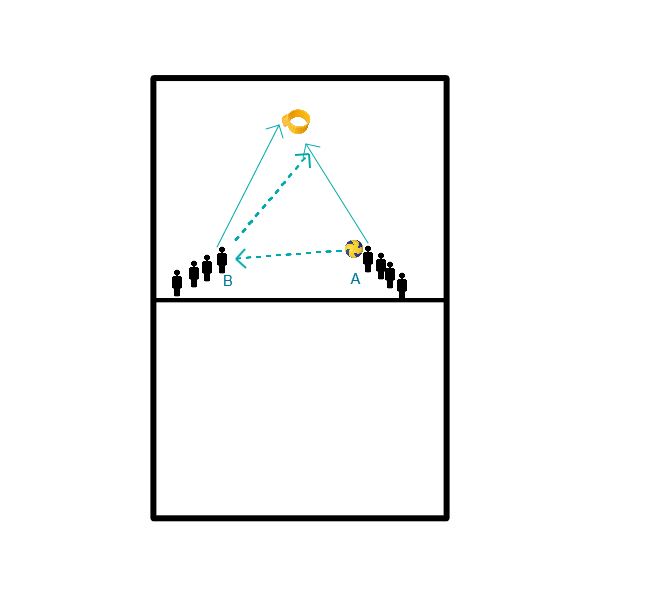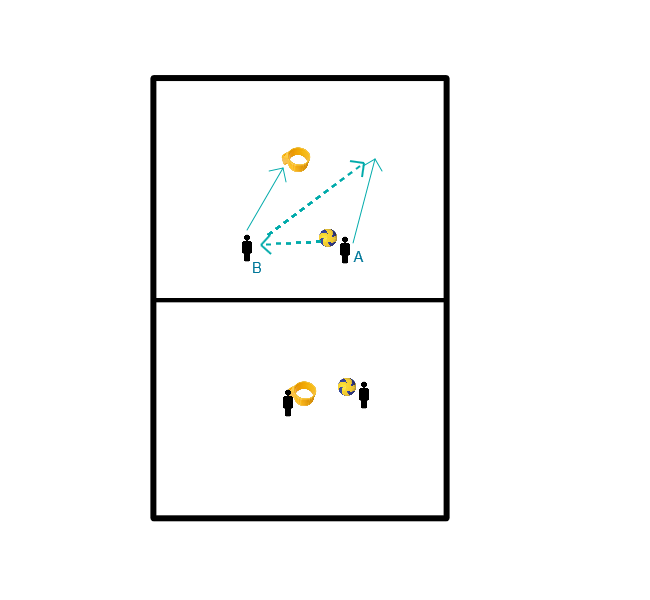Korfball drills for technique general
- Put a pole in the middle and divide your team in 2 groups.
- One group starts on the left, the other on the right (the right group (A) starts with the ball).
- Throw the ball to player B who stands left and walk directly to the basket for a walkthrough ball.
- You get this ball from the space of player B.
- Player B is going to catch.
As an alternative:
- You can start the ball at Player B.
- Throw to Player A and walk to the basket for support.
- Player A throws the ball to Player B and runs on for a walkthrough.
- See above but then Player A gets the ball for a walkthrough but does not take it but plays to Player B for a short chance. (Player B must then pull away).

Make two pairs.
- Start both at the front of the basket.
- Player A throws to player B and immediately runs a long line.
- Player B passes to the long line and goes to catch.
- Player A shoots, Player B catches.
Things to coach for:
- Make sure players are deflecting the long line toward the basket.
- Coach on throwing the long ball, make sure it is tight and arrives well.
- Try to shoot quickly so that your opponent is not right in front of you.
You can alternate this exercise by
- Don't let Player B catch the ball, but cut in for support.
- Let player A catch the ball first, throw it back immediately and then run the long line.
- Have Player B catch and then pull away for a short chance under the basket.

Start line-up
Two groups at the first two pawns.
Exercise
- The first in line runs to the hoop and goes through the hoop from the bottom, so the hoop goes over their heads.
- Then he runs through the defence posture to pawn two and circles this in 4 circles.
- Finally, he runs to pawn 3 and scores before he can run back to pawn 1 and tap the next one in line.
Set-up distance:
Hoop from pawn 1: 5 meters.
Pawn 2 from the hoop: 5 meter.
Pawn 3 from pawn 2: 5 meter.
Pole from pawn 3: 4 meter.

Inshort: exercises in catching balls that bounce or roll at the right moment.
Organisation: one ball per pair or trio.
(a) The numbers 1 and 2 of each pair stand next to each other. Number 1 rolls the ball a few metres away. Number 2 has to get the ball, pick it up and throw it back as fast as possible. Change after 5 games. Make sure the players 'get' the ball as soon as possible by putting one hand on it as soon as possible.
b ) As a., but now number 1 throws the ball away with a small curve, in such a way that it bounces on the ball at a distance of about 4 metres (and then makes a bounce of about half a metre high). Number 2 must try to get the ball as soon as possible after the bounce.
c ) As b., but now number 1 drops the ball from a height of 1.5 metres just in front of number 2. He/she has to try again to get the ball as soon as possible after the bounce. It will appear that almost everyone lets the ball rise a little and then catches it. Wrong (in the meantime an opponent can quickly put his/her hand on the ball). At the very moment that the ball is about to come up, the hand should be placed on the ball Take the ball!
Start line-up
Two groups at the first two pawns.
Exercise
The first in line runs to the hoop and goes through the hoop from the bottom, so the hoop goes over their heads. Then he runs through the defence posture to pawn two and circles this in 4 circles. Finally, he runs to pawn 3 and scores before he can run back to pawn 1 and tap the next one in line.
Distance set up:
- Hoop from pawn 1: 5 meters.
- Pawn 2 from the hoop: 5 meter.
- Pawn 3 from pawn 2: 5 meter.
- Pole from cone 3: 4 meter.

Inshort: exercises in catching balls that bounce or roll at the right moment.
Organisation: One ball per pair or trio.
- The numbers 1 and 2 of each pair stand next to each other. Number 1 rolls the ball a few metres away. Number 2 has to get the ball, pick it up and throw it back as quickly as possible. Change after 5 games. Make sure that the players 'get' the ball as quickly as possible by putting one hand on it as soon as possible.
- Like 1., but now number 1 throws the ball away with a small curve, in such a way that it bounces about 4 metres away (and then makes a bounce of about half a metre high). Number 2 must try to get the ball as soon as possible after the bounce.
- As 2, but now number 1 drops the ball from 1.5 metres just in front of number 2. Number 2 must again try to get the ball as soon as possible after the bounce. It will appear that almost everyone lets the ball rise a little before catching it. Wrong (in the meantime an opponent can quickly put his/her hand on the ball). At the very moment that the ball is about to come up, the hand should be placed on the ball Get that ball!
- Three teams, the person who gives the information stands in the middle. He rolls the ball a few meters away. As soon as the ball is loose, the other two may run. Who has the ball first? After 3 substitutions.
Practice with 4 players the free ball. Use 3 persons for the attack. Person 1 takes the free ball, person 2 and 3 pass. Person 4 defends the free ball on person 1.
- pass under the basket
- pass next to basket
- Attacker moves away from the basket and shoots directly.
- 1 attacker throws the ball to the person in front of the basket then he shoots the ball when he catches the ball under the basket he then goes inside and takes a walkthrough ball finally he takes a short chance.
- Point count:
- Shot counts 2x
- Walkthrough counts 1x
- Short chance counts 1x
- You can play this like this, for example, who is first to the 20 or
- 1min long and then look per basket who has the most points
! Form groups of 2 people per basket
Each group receives three cards. The cards are shuffled beforehand and the numbers 2 to 5 are taken from the packet. With the three cards they receive, the groups must get as close as possible to 31. The values of the numbers and pictures are shown below:
- Six = six
- Seven = seven
- Eight = eight
- Nine = nine
- Ten is ten
- Farmer = ten
- Wife = ten
- King = ten
- Ace = eleven
So nine + jack + queen = 29 points or ace + jack + queen = 31, but you can also get jack + jack = 30.5
When the players have completed a series, they may exchange one of their received cards for a new one, to get closer to 31. The trainer sets a timer and says stop when it rings. The team that is closest to 31 wins.
Series:
- Pass balls: three goals in a row.
- Short chance: four goals in total.
- Distance shot behind the basket: two goals in a row (4/5 meters).
- Penalty throw: three goals in a row.
- Around the basket: four goals, one on each side of the basket (3 metres).
- 2 groups of max 4. Distance between 2 groups is +/- 5 mtr
- 2 baskets/rings next to each other at 6 mtr from both groups. In the basket +/- 3 hats/buds etc.
- 1 pylon in a straight line opposite each group at 12 mtr
Each group takes one hat from its own basket, runs around the pylon at 12 mtr and puts the hat in the basket of the opponent. In this way they try to empty their own basket or they try to have less than the other team after e.g. 4 minutes.
VARIATION
- distance between pawns and/or basket
- time
first throw in = next throw in, otherwise it falls out
1) Ladder
2) Jumping in and out of the hoop
3) Sprint between 2 cones
4) Force ball over head and back down
5) Penalty throw
6) Jump between 2 cones with jump ball
7) Shots
8) Rotate ball around body
9) 4 cones, pull-up pass, sprint, pull-up pass and run backwards







